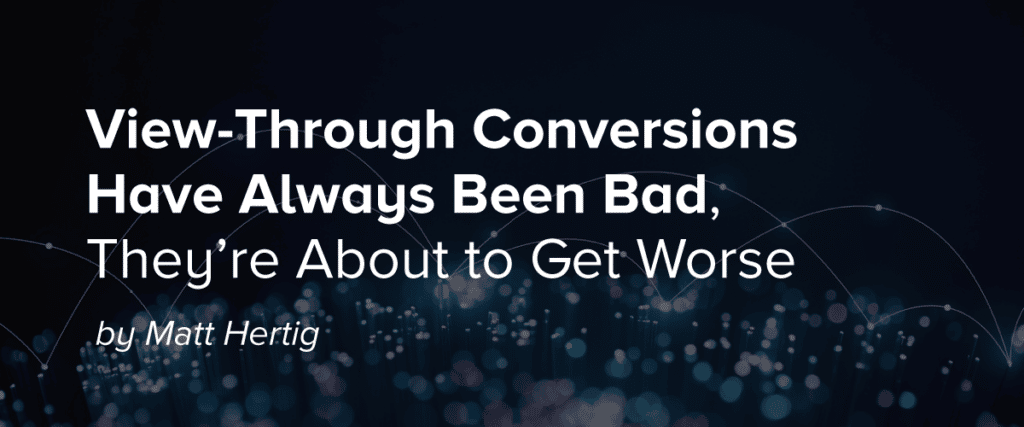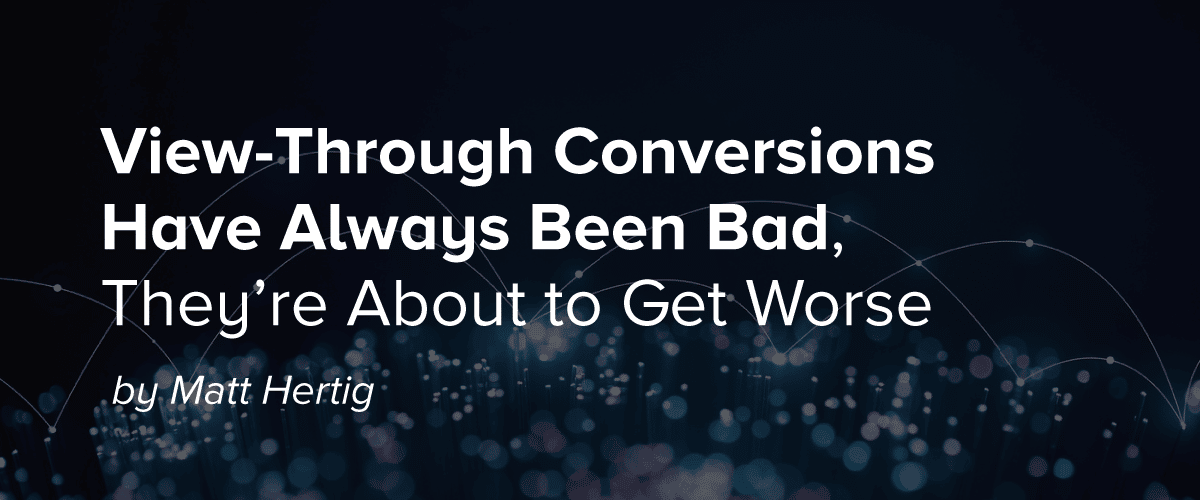
View-through conversions have become a popular ingredient in multi-touch attribution models. For those not in the know, a view-through conversion is a type of conversion tracking that measures how many visitors saw one of your ads, didn’t click, but eventually made it to your website and completed a conversion action. This is different from the data in your other conversion columns, which record when customers directly interact with an ad and then complete a conversion on your site.
The intent of view-through conversions is positive. Let’s try to attribute some value back to awareness-based tactics that may influence a buying decision but otherwise aren’t directly involved in the click path. The execution of view-through conversions, however, is problematic and about to get worse once browsers stop supporting 3rd-party cookies.
So if you’re still using view-through conversions to measure the impact of your campaigns, I’d urge you to reconsider. Let’s get into why.
View-through conversions sound great…on paper
People get to websites in all types of ways, and directly interacting with an ad isn’t always one of them. Perhaps they saw a billboard, heard a radio ad or saw a display ad, then went directly to your site. Those are all impression-based mediums, and it’s incredibly hard to attribute individual purchases to them. That’s why they’re typically only linked to awareness. View-through conversions are an attempt to attribute actual sales to those impression-based interactions.
Just like when grocery shoppers go to the store for milk and eggs and leave with $50 of other stuff, it doesn’t mean your digital ad didn’t influence your buyers to do something on your site later. A digital ad served to your audience at one point in time might get them to take a conversion action on a website later on, and your ad platform would take credit for the view-through conversion. Usually the window is about 30 days.
So in theory, this view-through conversion metric can be used to tell an ROI story, to prove the impact of marketing campaigns. It’s great for the ad platforms, it’s been embraced by ad agencies and is now simply accepted by brands.
In practice, this feels like marketing math, and fuzzy math will eventually erode your company’s confidence in marketing.
The unfortunate truth
View-through conversions leave way too much to interpretation. There isn’t a way to prevent over- or even under-counting conversions. Any metric that leaves that much open isn’t a good measure of value.
Here are three ways view-through conversion fall apart:
- The assumption is that the user saw the ad. There is no way to know that a user actually saw the ad. It simply records an impression. Thus an assumed “view” in a third-party cookie.
- Conversions reported by ad platforms will always be inflated. Like click-through conversions that use third-party cookies, view-through conversions will always lead to heavily inflated “value” numbers because all ad platforms want to take as much credit as they can.
- View-through conversions, like click-through media conversions, are NOT ROI metrics. At best, they are optimization metrics and should only be used to optimize the media—not show ROI.
If you want to tell an accurate ROI story, you cannot rely on view-through conversions. Your multi-touch attribution models need to be based on the actual click-action a user takes. The user may choose to take the conversion action or may leave the site. In both scenarios, marketing has created value by creating an “engagement.”
Engagement is where value begins with multi-touch attribution models. Rule-based attribution models using a first-party strategy will deliver a trusted ROI story based on actual clicks and conversions. Data-driven attribution models deliver a trusted ROI story based on all engagement, whether it results in a conversion or not, that marketing is delivering across marketing channels.
I can feel agencies starting to line up outside my door with torches and pitchforks. So let me be clear in saying that media impressions/views are still very important in understanding marketing performance. They just don’t belong in multi-touch attribution models. They belong in a media mix model, which is a completely different approach that looks at all variables in the marketing strategy and their impact on things like revenue to predict future results. Media mix models assign value to impressions and ensure that all media, both online and offline, are represented in the best possible way to understand value and ROI.
View-through and the cookieless world
By now, we all know that Google will join Apple and Mozilla in ending browser support for 3rd party cookies in 2023. And once Chrome goes dark, it will be almost impossible to see view-through conversions.
The only way forward is by building a true attribution model around engagement and conversions using a first-party solution. This is our future and must be implemented now so you don’t get stuck behind the privacy wall.
If you need help navigating these changes, let’s talk—our team can help. We can get you in a position to start using multi-touch attribution models the right way to drive actual results and marketing ROI without any fuzzy marketing math.
